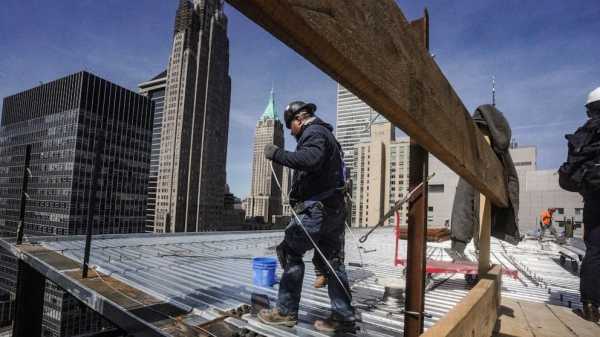
WASHINGTON — Month after month, the nation's job market has stood its ground against howling headwinds — rising interest rates, chronic inflation, major bank failures and economic uncertainties across the world.
Hiring has gradually slowed, along with pay growth and job openings. Yet by historical standards, the labor market has remained surprisingly strong, with an unemployment rate still hovering near half-century lows.
When the Labor Department issues the April jobs report Friday morning, it's expected to show that the trend has continued: Forecasters surveyed by the data firm FactSet predict that employers added 182,000 jobs last month. Though that would be well off the whopping 472,000 jobs that were added in January, the 326,000 in February and the 236,000 in March, it would still be a respectable gain that would show that many employers still need to fill jobs.
The unemployment rate is thought to have edged up to 3.6%, only slightly above a 54-year low of 3.4% set in January.
The job market has so far withstood the Federal Reserve’s aggressive drive to stamp out high inflation, which last year hit a four-decade high and is still well above the Fed's 2% target. On Wednesday, the Fed raised its benchmark rate for a 10th time since March 2022, a move that will likely further drive up borrowing costs for businesses and consumers.
Yet employers keep hiring.
Fed Chair Jerome Powell himself sounded somewhat mystified this week by the job market's durability.
“We’ve raised rates by 5 percentage points in 14 months" — from a range of 0%-0.25% to a range of 5%-5.25%, Powell said at a news conference Wednesday. “And unemployment is 3 1/2 percent — pretty much where it was, even lower than where it was, when we started.’’
The Fed has expressed concern that a robust job market exerts upward pressure on wages — and prices. It hopes to achieve a so-called soft landing – cooling the economy and the labor market just enough to tame inflation yet not so much as to trigger a recession.
One way to do that, Powell has said, is for employers to post fewer job openings. So far, so good: The government reported this week that job openings fell in March to 9.6 million — a still-high figure but down from a peak of 12 million in March 2022 and the fewest in nearly two years.
“It wasn’t supposed to be possible for job openings to decline by as much as they’ve declined without unemployment going up,’’ Powell said. “It’s possible that we can continue to have a cooling in the labor market without having the big increases in unemployment’’ that usually occur.
The Fed chair said he was optimistic that the nation could avoid a recession. Yet many economists are skeptical and have said they expect a downturn to begin sometime this year.
Another encouraging sign for the Fed is that more Americans are looking for work. The labor force — defined as the number of adults who either have a job or are looking for one — has grown by 1.8 million this year. The more workers who are available to employers, the less pressure employers face to raise pay.
Still, steadily rising borrowing costs have inflicted some damage. Pounded by higher mortgage rates, sales of existing homes were down a sharp 22% in March from a year earlier. Investment in housing has cratered over the past year.
America’s factories are slumping. An index produced by the Institute for Supply Management, an organization of purchasing managers, has signaled a contraction in manufacturing for six straight months.
Even consumers, who drive about 70% of economic activity and who have been spending healthily since the pandemic recession ended three years ago, are showing signs of exhaustion: Retail sales fell in February and March after having begun the year with a bang.
The Fed's rate hikes are hardly the economy’s only serious threat. Congressional Republicans are threatening to let the federal government default on its debt, by refusing to raise the limit on what it can borrow, if Democrats don't accept sharp cuts in federal spending. A first-ever default on the federal debt would shatter the market for U.S. Treasurys — the world’s biggest — and possibly cause an international financial crisis.
The global backdrop already looks gloomier. The International Monetary Fund last month downgraded its forecast for worldwide growth, citing rising interest rates around the world, financial uncertainty and chronic inflation.
Since March, America's financial system has been rattled by three of the four biggest bank failures in U.S. history. Worried that jittery depositors will withdraw their money, banks are likely to reduce lending to conserve cash. Multiplied across the banking industry, that trend could cause a credit crunch that would hobble the economy.
So was April the month when the job market finally started to crumble? Economists are betting probably not.
This week, the payroll processor ADP reported that private employers added a lofty 296,000 jobs in April. And Goldman Sachs’ economic team offered a rosy forecast: It predicted that employers added 250,000 jobs in April, well above the consensus estimate.
At the staffing firm Robert half, executive director Ryan Sutton still sees “pent-up demand’’ for workers.
Applicants, not employers, still enjoy the advantage, he said: To attract and keep workers, he said, businesses — especially small ones — must offer flexible hours and the chance to work from home when possible.
“Giving a little bit of schedule flexibility so that somebody might finish their work late or early so that they can take care of children and family and elderly parents — these are the things that the modern employee needs,’’ Sutton said. “To not offer those and to try to still have a 2019 business model of five days a week in an office — that’s going to put you at a disadvantage" in finding and retaining talent.
___
AP Economics Writer Christopher Rugaber contributed to this report.
Sourse: abcnews.go.com






